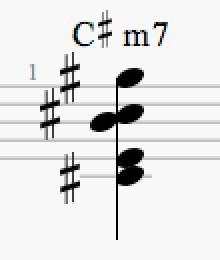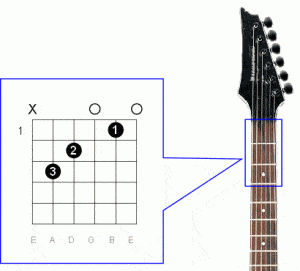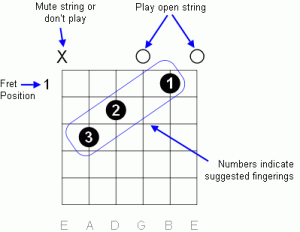You don’t have to be able to read sheet music in order to play simple guitar. In this article I’ll explain how to read guitar chord diagrams used in guitar tabs available freely online.
Reading Chords On Sheet Music
One of the issues you face when reading sheet music is the chord symbol. This is the musical symbol that describes the harmony at a specific place in a piece of music:

Sheet Music Chord Symbols
For example, let’s take C#m7. This tells you that the chord is a C sharp minor seven chord:

C#m7 Chord
While that’s all well and good, how do you kno what notes to use to create this chord on a guitar without an extensive knowledge of music theory? This is where chord diagrams come to the rescue.
What Is a Guitar Chord Diagram?
Most sheet music and tabs generally have guitar chord diagrams which can show you how to actually fret chords. Guitar chord diagrams make it possible for you to play a chord without even knowing what notes are in them. These diagrams work by illustrating where to place your finger on the fretboard rather than using generalised music notation.
A guitar chord diagram is made up of a grid of five horizontal lines and six vertical lines representing the guitar fretboard.

Chord Diagram Illustration
How to Read Guitar Chord Diagrams
- The vertical lines are the guitar strings. From left to right, the lines represent the strings E, A, D, G, B, and E.
- The frets are represented by the horizontal lines. The thick line at the top signifies the nut of the guitar at the start of the fretboard.
- The dots on the vertical string lines illustrate exactly where to place your fingers, and sometimes the notes you fret with your left hand (or right if you are left handed!).
- An O indicates a string that is to be left open, or ‘unfretted’.
- An X indicates you do not use this string when playing a chord.
- Where a chord is fretted somewhere other than the first four frets, the number of the first fret in which a note is fretted is usually placed to the left of the diagram.
- Chords that use the initial 4 frets generally use open strings and are simpler to participate in. Therefore, they are a lot more popular in chord diagrams.

Chord Diagram Finger Placement
Fingering Numbers
- The number within the dots indicate the suggested finger you use to fret the note:
- 1 = Index finger
- 2 = Middle finger
- 3 = Ring finger
- 4 = Little finger.

Guitar Fingering Numbers
That’s all there is to it! So when you look for sheet music or tabs online, just make sure they have guitar chord diagrams, and you can get playing some music in no time at all!
Once you’ve mastered the basics, you may want to check out how to build on basic guitar chords for beginners.


























